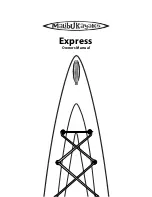
45
d. Disconnect Procedure
1. Turn off ship's main breaker.
2. Turn off dockside power and disconnect cord.
3. Replace all weather-tight caps on receptacles.
CAUTION:
The owner must be aware of the hazards of using high voltage AC aboard ship, and
should maintain this system in safe condition. (See Section V). Don't take chances handling AC
equipment in wet weather or while washing down topsides. Caution guests and children about
hazards, and do not use any equipment that does not function properly or is suspected of being
defective.
e. Battery Charger Option
The battery charger, or converter as it is also referred to, is connected to the feed or "output"
side of the main battery switch. This allows you to select either or both batteries to be put "on the
line" for charging when the engine is at rest. It also insures that, when the battery switch is OFF,
all circuits are positively disconnected from the batteries during an emergency shutdown. Do not
turn the battery charger on when the battery switch is in the OFF position. This could possibly
feed the ship's circuits without the back-up support of the batteries. It could also cause premature
failure of electrical equipment in the boat and if the regulator section of the charger should fail,
allow high voltage into the system. The battery charger has an automatic cut-off circuit, which is
wired to the engine electrical system. Whenever the engine is started, the charger will shut off and
allow the engine-driven alternator to take over, returning to service when the engine is stopped (if
the charger is powered by either a generator or shore power). The charger is protected by
internally mounted fuses on the AC and DC circuits, as well as the main circuit breaker on the AC
panel. Be sure all the related circuits are OFF when opening the charger cabinet for service. The
charger is an air-cooled unit with louvers on top and bottom. Care must be taken not to restrict the
ventilation provided, nor allow small tools or hardware to fall into the charger while performing
maintenance work. If left on at the pier, the battery charger should cut off automatically when the
batteries are fully charged, but many do not.
G. The Plumbing Systems
Your yacht has several plumbing and sanitation systems which, while easy to operate, require
some care to avoid spills or the pumping of waste overboard when that is not the intention. Figure
IV - 5 shows a V-42 fresh water system. Figures IV - 2 and 3 are also pertinent. Figure IV - 6
shows a typical waste water plumbing system and Figure IV - 7 shows a partial plumbing system
for a V-42 CC two head system.
1. The Fresh Water System
Tankage consists of two 70-gallon stainless steel tanks located beneath the cabin sole in the
main cabin. Valves are located above the port tank to control the water supply to the electric water
Содержание VANCOUVER 42
Страница 1: ...1 OPERATIONS AND MAINTENANCE MANUAL TAYANA VANCOUVER 42...
Страница 2: ...2 Tayana V 42 Center Cockpit Sailplan...
Страница 3: ...3 Tayana V 42 Aft Cockpit Interior Layout...
Страница 12: ...12 Figure II 1 Fiberglass Layout Schedule...
Страница 13: ...13 Figure II 2 V 42 Deck and Hull Joint...
Страница 19: ......
Страница 37: ...37 Figure IV 1 Fuel Supply Plumbing...
Страница 38: ...38 Figure IV 2 Fluid Plumbing System...
Страница 39: ...39 Figure IV 3 Center Cockpit Tankage Diagram...
Страница 43: ...43 TABLE IV 1 Direct Current Energy Audit...
Страница 48: ...48 Figure IV 6 Waste Water Plumbing System...
Страница 51: ...51 Figure IV 8 Propane System...
















































